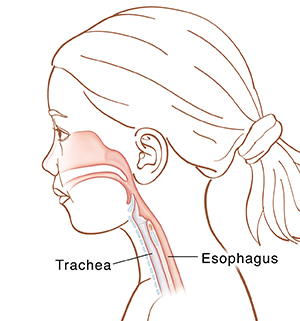When Your Child Swallows An Object
When Your Child Swallows An Object
Young children often put small objects in their mouths, such as marbles, pins, or coins. These objects may be accidentally swallowed. This can be scary, it's not always cause for concern. Most often, the object will pass through your child's body without harm. But in some cases, an object may become stuck in the tube leading from the mouth to the stomach (esophagus) or windpipe (trachea). In that case, your child needs medical care right away. Hours to days later, the object can become stuck in the intestine.
When to go to the emergency room (ER)
Contact your child's healthcare provider if you think your child has swallowed an object. Don't try to remove the object yourself. This may cause more harm. Go to the ER if your child:
Has trouble breathing, speaking, or swallowing
Is spitting up saliva or vomiting
Has chest pain, stomach pain, or pain when swallowing
Is vomiting blood or passing blood from the rectum
What to expect in the ER
A healthcare provider will ask about the swallowed object and give your child a physical exam.
X-rays may be taken to help find the object. This depends on your child's symptoms and what the object was.
In some cases, a barium swallow test or computed tomography (CT) scan may be done. One of these tests may be done if you suspect but aren't certain that your child swallowed an object, and it doesn't show up on an X-ray. In a barium swallow, your child drinks a thick liquid and X-rays are then taken. CT scanning is a test that uses a series of X-rays. It may be done if the healthcare provider thinks an abscess has formed or is worried about rupture of the digestive tract. This scan helps the healthcare provider see objects that may not show up on other tests.
Treatment
Treatment will depend on the type of object and where it's located. Your healthcare provider may suggest one of the following:
Watchful waiting. A smooth object that has not gotten stuck may pass on its own in 24 hours or a few days. The object may be checked over time by a series of X-rays.
Endoscopy. To remove an object and check for any damage, a lighted, telescope-like tube (endoscope) may be used. The scope is put down into the esophagus through the mouth. Your child will be given medicine so he or she sleeps through the procedure. The object can be removed from the esophagus, stomach, or small intestine.
Surgery. If an object does not pass in a certain amount of time and can’t be removed with a scope, surgery may be needed.
Follow-up
Call your child's healthcare provider or return to the ER if your child:
Has nausea or vomiting
Has bloody vomit or bloody stools
Has severe abdominal pain
Prevention
Clear your home of loose objects that can be ingested by a child. This includes batteries (especially button batteries), loose magnets, and sharp objects.
Updated:
March 24, 2018
Sources:
Airway foreign bodies in children. UpToDate., Button and cylindrical battery ingestion. UpToDate., Foreign bodies of the esophagus and gastrointestinal tract in children. UpToDate.
Reviewed By:
Freeborn, Donna, PhD, CNM, FNP,Lehrer, Jenifer, MD
